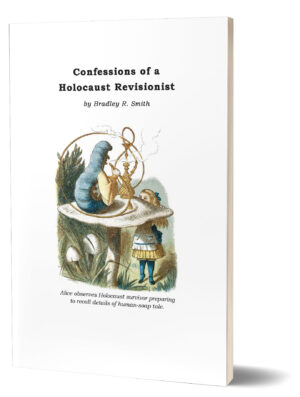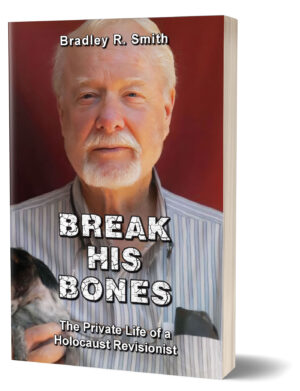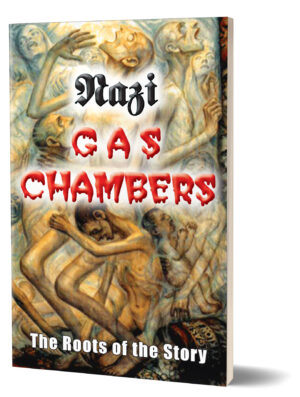Book Announcements
Confessions of a Holocaust Revisionist
Authored by Bradley R. Smith
Bradley R. Smith, Confessions of a Holocaust Revisionist, 4th, annotated edition, Armreg Ltd., London, 2024, 132 pages, 9”×6” paperback, ISBN: 978-1-83640-000-4.
In August of 2024, the resurrected Committee for Open Debate on the Holocaust decided to republish in new editions all the books that CODOH’s founder Bradley Reed Smith has written during his lifetime. This is meant to honor our founder’s legacy, which is an indelible and proud part of CODOH’s history and legacy as well.
All in all, this concerns four books. Bradley’s first, 1987 book is also the easiest to republish, as it was rendered as an eBook edition posted on CODOH’s website not too long ago. So here it is. It can be purchased as paperback or eBook (ePub or PDF) from Armreg Ltd.

This is the extraordinary story of an ordinary American who couldn’t help but develop doubts where society doesn’t allow doubts. In an attempt to overcome those doubts, he asked questions that society does not tolerate; and he gave answers that society suppresses to this day by any means.
This autobiographical book interweaves two narrative strands. The first spans the early years of his conversion to the status of an ostracized doubter in 1979 and 1980, describing the inner turmoil he experienced when one day, by sheer coincidence, he discovered he had believed something all his adult life about Germans and Jews that he now realized may not be true at all. The other strand tells episodes of Smith’s fledgling activities during the mid-1980s when he started asking questions and probing for answers about his doubts, lobbying for a free exchange of ideas and a free press where the powers that be had no interest in it.
This book chronicles the budding of what was to become the world’s most effective campaign so far conducted, aiming at implementing an open debate on the West’s last standing taboo subject. It describes the beginnings of the Committee for Open Debate on the Holocaust, which was formally established just around the time the first edition of this book was published.
This is an earthy, humorous, unsparing and compelling account of how Smith’s confrontation with his last frontier of unwarranted belief – the Holocaust story – changed his life due to the resulting struggle to balance the right relationship with men, women and ideas.
Break His Bones
Authored by Bradley R. Smith
Bradley R. Smith, Break His Bones: The Private Life of a Holocaust Revisionist, 2nd, expanded edition, Armreg Ltd., London, 2024, 326 pages, 9”×6” paperback, ISBN: 978-1-911733-99-7.
I remember helping Bradley put together the first edition of this book back in 2001/2002, as he had no experience on how to prepare print-ready interior and cover files that he could bring to a printer for self-publication. In fact, I read parts of this biography already in 2000, when I lived for a few months next to Bradley’s home in Rosarito, Baja California, Mexico. During those weeks, we shared many dinners and lots of good conversations. I came to appreciate his wisdom and down-to-earthness, but most of all his unbreakable cheerfulness, humor and optimism. Break His Bones reflects all this, and more. It can be purchased as paperback or eBook (ePub or PDF) from Armreg Ltd at armreg.co.uk.
Germar Rudolf

Bradley R. Smith was an author, playwright and free-speech activist. He served in the U.S. Armed Forces in Korea, where he became a combat veteran and was twice wounded. He was a deputy sheriff (Los Angeles County), a merchant seaman, a bookseller on Hollywood Boulevard, an activist for free speech (he was prosecuted for intentionally selling a book then banned by the U.S. Government – Henry Miller’s Tropic of Cancer), and was a freelance writer in Saigon during the TET offensive of 1968. Smith was married to a native Mexican woman; they have two daughters.
Beginning in the early 1990s, Smith ran essay-advertisements in student newspapers at colleges and universities around the country, calling for intellectual freedom with regard to the orthodox Holocaust narrative. He was interviewed on hundreds of radio talk shows, by scores of print journalists, and appeared on numerous television programs, including 48 Hours, Phil Donahue and Jerry Williams.
Pursuing this American ideal of free inquiry and open debate put him at enmity with those who represent what Norman Finkelstein has so aptly termed the “Holocaust Industry.” Organizations such as the Anti-Defamation League of B’nai B’rith, blinded by their own extremism, routinely lumped Smith together with racialist extremists, because he was a “skeptic” with regard to the orthodox Holocaust story.
In the pages of this book, the reader encounters possibly the most-legendary face of Holocaust skepticism – and discovers that it is a very affable one. This is the antidote to the slander and false accusations that the Holocaust Industry makes against those who don’t take the orthodox Holocaust narrative at face value. This is the story that reveals the programmatic suppression, censorship and taboo by the Industry to limit intellectual freedom with regard to their narrative. Here you will discover why an organization like the ADL is driven to make the ludicrous charge that this libertarian author was one of the “Top Ten Extremists” in America. Smith, on the other hand, remained an incorrigible believer in a free press, and that open debate is preferable to close-mindedness and censorship.
If you want to know what it is like to try to convince intellectuals that it is better to encourage intellectual freedom than to discourage it, read this unusual mix of autobiography and political journalism. This book, the controversial and compelling Part 2 of Smith’s earlier Confessions of a Holocaust Revisionist, brings “the other side” to the Holocaust debate. Everyone should test the authenticity of their own beliefs in intellectual freedom by reading this book.
Nazi Gas Chambers
Authored by Germar Rudolf
Germar Rudolf, Nazi Gas Chambers: The Roots of the Story, Armreg Ltd., London, 2024, 146 pages, 8”×5” paperback, index, bibliography; ISBN: 978-1-911733-96-6.
While I was writing the Holocaust Encyclopedia (see www.HolocaustEncyclopedia.com), I had a number of epiphanies resulting from the fact that I had to get so many facts straight, and make everything consistent and coherent. I started connecting dots between seemingly isolated facts which I had never seen before. One of them was the realization that there was actually a plot to create the orthodox gas-chamber narrative as we know it today. That conspiracy is not what most people think it is, though. Hence, I thought it important to take those facts, scattered throughout the Encyclopedia, and put them all together in one book, connecting the dots for the reader, and explaining it all. As usual, this book can be purchased as paperback, eBook (ePub or PDF) and audio book (mp3) from Armreg Ltd at armreg.co.uk. This issue of Inconvenient History also features an article titled “Who Put the Gas into the Chambers?” which introduces and summarizes this book in a nutshell.
Germar Rudolf

We all know the iconic core of the Holocaust narrative: the Nazis used gas chambers to kill millions of Jews with poison gas. However, if we dig a little deeper to uncover the roots of the story, we find early accounts from the wartime and immediate postwar period that tell quite a different story. They speak of steam chambers, vacuum chambers, electrocution chambers, murder with chlorinated lime in trains, or with toxic fluids. How did we get from this bizarre assortment of claimed murder methods to where we are today?
First, someone clouded the historical record, and then someone else (?) cleaned it up. But who did what? There’s no shortage of culprits for inventing atrocity stories, because all countries involved in World War II spread atrocity tales about their enemies. But when it comes to separating what we are told is true from the admitted propaganda, opinions diverge on how it was done.
This book reveals exactly who cleansed the historical record to create an apparently consistent and coherent narrative, and which methods they used. Those looking for evidence of a huge Jewish conspiracy, however, will be disappointed, because that’s not how it happened. Instead, the details of the conventional gas-chamber story were defined and documented by… well, read the book and find out!
Bibliographic information about this document: Inconvenient History, 2024, Vol. 16, No. 3
Other contributors to this document:
Editor’s comments:
